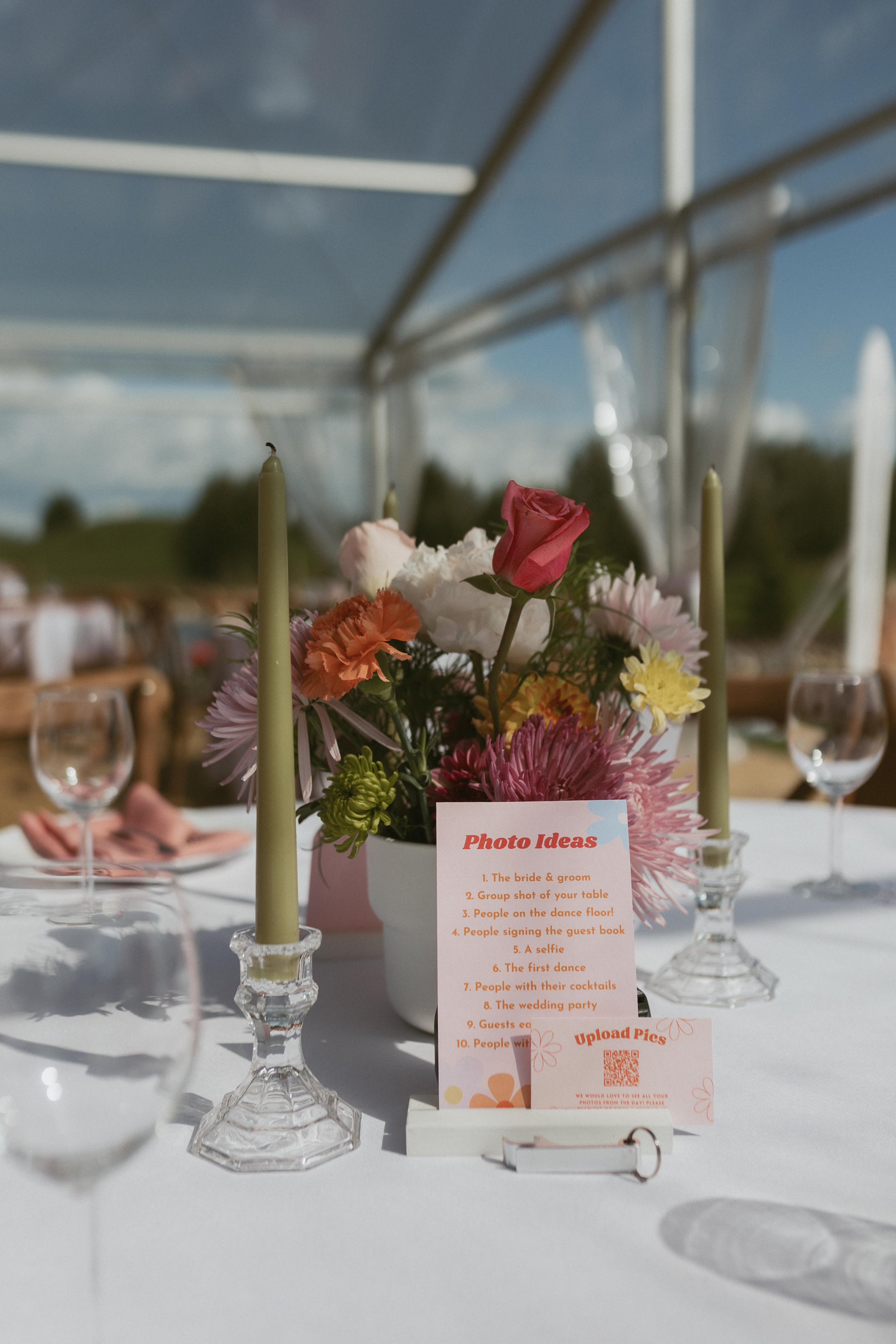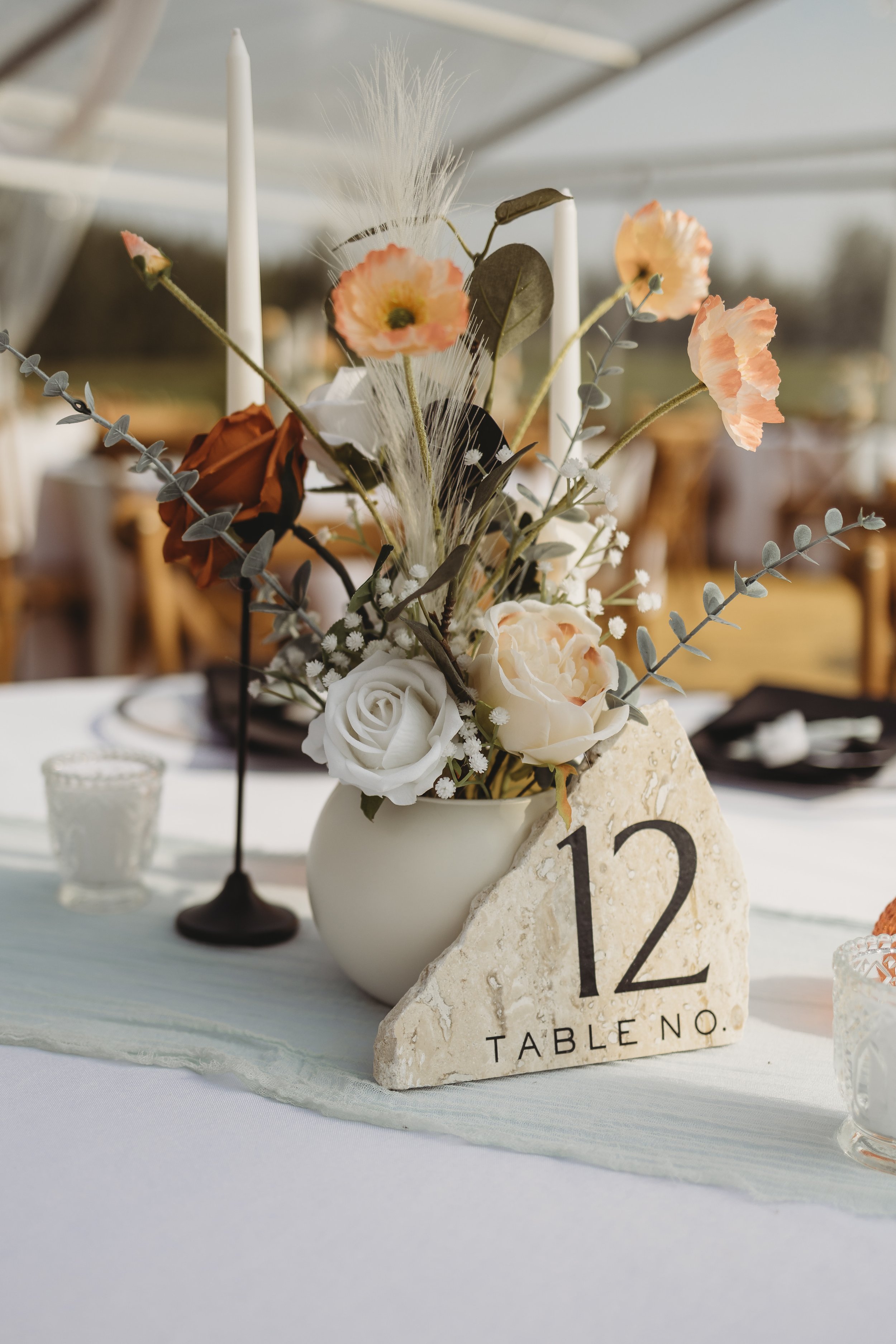THE ULTIMATE GUIDE TO NUMBERING TABLES AT YOUR WEDDING
If you want a well-organized reception, table numbers are key. From ensuring a seamless guest experience to simplifying work for the wait staff, reception table numbers keep it all together. Read ahead for a complete guide on how to number tables at your wedding so your reception goes off without a hitch.
THE BASICS OF TABLE NUMBERING
The purpose of a seating chart is to make the transition from your ceremony to reception go smoothly. After cocktail hour is over, you want your guests to find their seats quickly so you can start the fun on time. A table numbering system makes this process easy for guests when the big day arrives.
Thoughtful table and seating arrangements can make quite an impact on the overall flow of your post-ceremony festivities. Even in a smaller celebration, a seating plan avoids delays in getting to the dinner and dancing. Plotting guest table assignments gives you the opportunity to plan details such as food service and wedding party toasts. With organized table numbers, there’s no worrying about a crowd of hungry guests creating a bottleneck in the ballroom. They can just go right to their table and enjoy your delicious wedding catering menu.
DIFFERENT METHODS FOR NUMBERING TABLES
The concept of table numbering is fairly straightforward. Each guest table is given a number, usually depending on where the table is placed, similar to a restaurant seating chart. In weddings, it’s also common for table numbers to correlate with roles in the wedding. For example, many label the head table as number one, with the couple and/or wedding party.
Since the goal is to help guests find their tables quickly, it’s important to plan your seating chart with some kind of intuitive order. Sequencing tables in numerical order certainly makes it easy to do just that. If you’re assigned to table five, and you see table four, you know you’re getting warmer. But you don’t have to categorize tables by simple numbers only. There’s still plenty of room to get creative and throw in a little personality with your table numbering system.
Some couples create unique table names for their wedding reception. This is a great chance to incorporate something that means a lot to the two of you. Did you initially bond over a shared love of music? You can label tables by song or band names. Again, though, you want to take the guesswork out for guests. If you’re creating a naming system, for example, by Alberta landmarks, you can organize tables alphabetically — i.e., the Saddledome table should be right after the Muttart Conservatory table. Or you can have the best of both worlds and add numbers to each table name.
TOOLS FOR TABLE NUMBERING
You’ll need three essential materials for organizing your wedding day table numbering system: A seating chart, table number signs, and a guide to find seats, typically escort cards.
After you plan where everyone should go on your seating chart, table number cards are used to physically mark each table correctly. Then on your special day, you can give escort cards to each guest, with their name and corresponding table placements.
All cards and signage should be easy to read, but there’s still plenty of room to add a personal touch here. Even if you’re opting for a straightforward numeric system, framing your table numbers can add a touch of elegance.
While physical paper cards are generally the easiest for day-of logistics, there’s no reason you can’t go digital with the planning part. There are numerous options for digital table charts, so you don’t have to worry about keeping a big paper seating chart intact. Instead of moving sticky notes around or constantly erasing names, drag and drop features make it easy to move people around as your RSVPs come in. And most platforms have the tools you need to print everything for the big day.
HOW TO PLAN YOUR TABLE NUMBERING
Below is a step by step guide on how to efficiently number your tables, so your reception goes according to plan.
ORGANIZE GUESTS INTO TABLE GROUPS
It can help to start with who should be seated together. You can make minor edits as you need later, but an initial plan can keep things organized. Divide up your guest list into groups, based on how many chairs are at each table. It’s good wedding etiquette to keep couples and families together. From there you can apply your personal knowledge about each guest.
Maybe you want to have a table just for your friends from college. Or maybe you’ve got a baseball playing friend with no plus one, who would have lots to talk about with your die-hard Blue Jays fan cousin. This is where you decide which personalities will get along best.
DECIDE IF YOU WANT SPECIFIC SEATING
Some couples choose to assign each individual seat at a table, so guests know exactly where they’re meant to be. This can facilitate things such as speeches, if you want to make sure anyone giving a toast has an easy path to the mic. And if you’ve got guests with dietary restrictions, it can help the venue and catering staff make sure everyone gets the right plate.
But if you prefer to keep things a little more casual, it’s also common for couples to only assign a table number. Giving guests some choice could even lead to some unintended matchmaking, if guests you might not have placed together end up hitting it off. Think about your guestlist and determine which system works best for you.
CREATE A FLOOR PLAN THAT FLOWS
Get a clean copy of your venue’s floor plan, so you can account for reception hall size and layout. Once you work out spacing and table location, you can plug in your table numbers and if you choose, seating assignments.
As you start to solidify actual guest placement, be mindful of everyone’s needs. For instance, parents with small children might appreciate being near an exit, so they can step away easily if their little one gets fussy. If you have guests who need special accommodations, you should also factor that in before finalizing table placement.
HOW DO YOU TELL GUESTS THEIR TABLE NUMBER?
If you’re going the traditional route of escort cards, it’s common to place them at a table near the reception entrance. You can order cards alphabetically by guest name to speed things along. Some couples prefer to skip the individual cards and have one large sign that lists out all table assignments, also near the reception hall entryway.
Either way, it can help to station someone near the escort card table or seating chart to help answer questions and direct guests as needed. If you’re putting guests in specific seats, you can also note this with the help of table place cards. They can still find their table numbers with the help of an escort card or seating list. And then they’ll locate their individual seat, noted with a card at their place setting.
TABLE NUMBERS MAKE YOUR BIG DAY EASIER
Your particular table numbering system will depend on your venue, the space, and size of your guestlist. But if you follow these guidelines for the basics, there’s plenty of room to personalize. Just like every detail of your wedding day, your table numbering should be uniquely you. And when you’re ready to plan your full dream reception, the team at Gardenview Estate is here to help.








